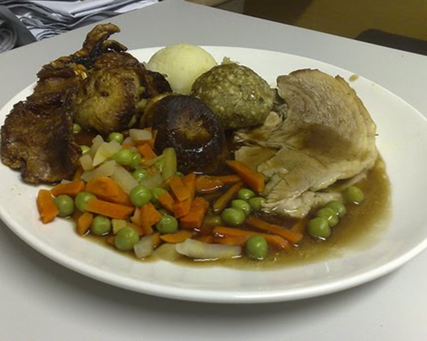Lunch is an important and special part of our day.
It is a time for us to gather together as a community. We model lunch times on family style eating and create meal arrangements which foster a sense of collaboration and social responsibility. Children sit in mixed age group tables. They use crockery and cutlery.
Adults who work within the school regularly eat with the children, offering an ideal opportunity for role models and coaches to have informal contact with pupils.

Our meals are cooked on site by our chef. Allergies and dietary requirements can all be catered for.
School meals are free to children in Reception, Year 1 and Year 2 via Government funding and for the academic year 24-25 for all of KS2. As much as possible we encourage children to eat school meals to encourage them to try different foods and explore new flavours. However, if you prefer, you can also provide your child with a packed lunch.
Hope School: a Nut Free Zone.
Please help us to keep the school a nut free zone, as we have a number of people who have severe allergies to nuts and sesame seeds. Please do not send your child to school with peanut butter or Nutella sandwiches. When families provide confectionery or cakes to celebrate birthdays, please make sure you do not send in sweets or chocolates or cakes with nuts in.
To help children with food allergies and for families to know what their child has eaten, we ask children not to share their packed lunches.
Hope School Guide to Healthy Packed lunches
Hope’s Healthy Packed Lunch Initiative
At Hope Community School we are promoting healthy packed lunches.
Government packed lunch advice
The UK government produced packed lunch guidance to support the implementation of new school food standards for school lunches and ensure that all children benefit from eating quality food during the school day.
The guidelines are:
- One portion of fruit and one portion of vegetable or salad every day to be included in packed lunches
- Meat, fish or another source of non-dairy protein should be included every day. Non-dairy sources of protein include lentils, kidney beans, chickpeas, hummus, peanut butter and falafel
- An oily fish, such as salmon, should be included at least once every three weeks
- A starchy food, such as bread or pasta, rice, couscous, noodles, potatoes or other cereals, should be included every day
- A dairy food, such as semi-skimmed or skimmed milk, cheese, yoghurt, fromage frais or custard should be included every day
- Free, fresh drinking water should be available at all times
- Include only water, still or sparkling, fruit juice, semi-skimmed or skimmed milk, yoghurt or milk drinks and smoothies
- Snacks such as crisps should not be included. Instead, include seeds, vegetables and fruit (with no added salt, sugar or fat). Savoury crackers or breadsticks served with fruit, vegetables or dairy food are also a good choice
- Confectionery such as chocolate bars, chocolate-coated biscuits and sweets should not be included.
- Cakes and biscuits are allowed but these should be part of a balanced meal
- Meat products such as sausage rolls, individual pies corned meat and sausages / chipolatas should be included only occasionally.
A good packed lunch contains: 
- A starchy food, such as bread, rolls, pitta bread, naan bread, potatoes, rice, noodles. These foods are good for children to fill up on.
- A good source of protein, iron and zinc such as meat, fish, beans or eggs.
- A good source of calcium such as milk, cheese, yoghurt or fromage frais.
- One portion of fruit and one portion of vegetable or salad to provide all the other vitamins and minerals. A piece of fruit could be a 100% juice or piece of fresh fruit, dried fruit or tinned fruit in fruit juice. A piece of vegetable could be a fresh vegetable such as carrot stick, salad or a vegetable soup or vegetable dish.
- No single food contains all the essential nutrients the body needs to be healthy and function efficiently so it is important that the content of the packed lunch is varied.
What about snacks such as crisps, cakes, pastries and sweets?
These foods should only be given occasionally. Children will then appreciate them more.
If these foods are included in packed lunches they might eat these first and not have the appetite to eat the other foods that will provide them with the important nutrients they need to grow and develop, be healthy and active.
A child at school should have about a third of their daily nutrient requirements at lunchtime. This means they need food that are going to provide them with enough energy, protein, fibre, vitamins and minerals.
A healthy packed lunch should contain a mix of foods from the EatWell Plate. The EatWell Plate shows how much should be eaten from each of the 5 food groups.

